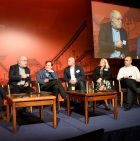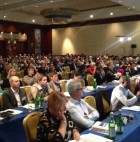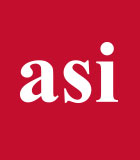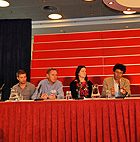2019 asi International Publishing & Data Conference
Thursday 12th - Friday 13th September 2019
Context, cross-platform and cost: priorities for measurement?
The 2019 International Publishing & Data Conference focused on data at the heart of the publishing industry, data driving audience measurement, advertising effectiveness, content development and revenue models. The conference is an essential event for all those involved in the production of publisher data and those who use that data to make vital business decisions.
Whilst significant challenges for newsbrand and magazine publishers remain, nonetheless there are reasons for optimism. It is becoming increasingly clear that, as opposed to simply managing a gradual transition from profitable print businesses to a less profitable and less differentiated online model, the future is a hybrid, cross-platform one in which print remains valued by many and coexists with publishers’ online efforts.
So how can newsbrands and magazines preserve and demonstrate their unique value to advertisers in such a complex and competitive eco-system? We highlight a number of initiatives that focus on the vital importance of context in enhancing the power of publisher advertising and the unique strength of newsbrands and magazines.
We identify the specific challenges in the online battleground: the strategies needed to have an optimal relationship with digital platforms and social media that widens brand reach without losing brand attribution.
Can we identify, classify and understand newsbrand and magazine audiences in ways that optimise the delivery of content, but also bring publisher audiences to life for advertisers?
How can publisher data best interface with the digital eco-system, a world of APIs, DMPs and programmatic real-time ad placement and trading?
Meanwhile, the debate continues to rage about optimum business models, not just the blend of print and online but revenue models incorporating subscriptions, ad revenue or a hybrid of the two.
Above all, we face a measurement challenge, specifically the cost of tracking publisher brands across multiple platforms. How can we measure more for less? How can we expand currencies across platforms, whilst preserving robust measurement of hardcopy readership? What are pragmatic and acceptable compromises on survey quality?
How will the availability of census data and innovations like AI drive print measurement going forward? Can developments in data science enable us to model more effectively readership of smaller publications? There seems to be a widening gap between newspaper and magazine requirements. Can this gap be filled or should they go their separate ways?
Is the future not just cross-platform measurement but cross-media measurement?
The emphasis in Lisbon was on actionable insights from engaging data experts and users around the world. Our goal is to inspire delegates with new thinking and approaches, with insights you can take back to your own businesses and effect real change.
The 2019 International Publishing & Data Conference was generously sponsored by Ipsos and Kantar.
![]()
![]()
-
- Session Will publishing survive until 2030?
- Date Thursday 12th September 2019
- Time 09:30 - 12:30
-

09:30
Chairman's opening remarks, followed by 'Will publishing survive until 2030?'
Colin Morrison, Former Media CEO, Consultant and Editor of 'Flashes & Flames'
Colin Morrison OBE is a former journalist who has been CEO of magazine, B2B and news companies in the UK, Europe and the AsiaPacific. He is now variously a director and consultant of media companies in the UK, US and Australia. He also writes the award-winning Flashes & Flames blog on media disruption (www.flashesandflames.com).
-

09:55
'I read it on Facebook' – the BBC News Attribution Study
Santanu Chakrabarti, Head of Audience Insight, BBC World Service
How much attribution accrues to content brands on Facebook? The BBC’s innovative global Attribution Study suggests there is cause for grave concern.
Santanu Chakrabarti is Head of Audience Insight at the BBC World Service, leading a team that delivers strategic insight using quantitative, qualitative, analytics and data science methodologies. He has experience in commercial, charity, academic and public servic sectors e in marketing, strategy and research roles.
-

10:10
From big data to actionable insights
Hanne Brasseur, Audience Engagement and Analytics, VRT NWS
How data analytics can be translated into hands-on advice for growing a loyal audience by helping editors with editorial and strategic decisions in a busy newsroom.
Hanne Brasseur initiated Audience Engagement and Analytics at VRT NWS, where she helps online editors use data to grow the reach and impact of VRT journalism. Previously she worked for VRT’s television news as researcher, producer and foreign editor. Combining realtime and historical data with an editorial perspective, she offers strategic advice to both newsroom management and staff.
Hanne has Master’s degrees in Linguistics and Literature (Dutch/English) and Journalism. She speaks Dutch, English, French and German. She lives in Belgium with her husband and two sons.
-

10:25
What newspaper readers really want: learnings from seven years of reader research with 'Lesewert'
Ludwig Zeumer, Executive Director, Die Mehrwertmacher
A real-time newspaper and magazine tracking tool, ‘Lesewert’ has been used by 16 publishers including Der Spiegel. More than 11,000 print readers passed through the panels over several months and generated more than 15 million individual reader feedbacks.
-

10:40
Panel session
Will publishing survive until 2030?
-

11:00
Coffee
-

11:30
From Viral to Tribal – the next frontier of publishing
Stuart Wilkinson, Head of Industry Relations EMEA, comScore
How should rapidly-changing publisher business models evolve to allow for generational differences in digital news consumption?
-

11:45
Why didn’t we think of this before?
James Hewes, President & CEO, FIPP
The FIPP Digital Subscriptions Snapshot tracks the industry’s most critical revenue stream and provides valuable insights from a number of countries.
-

12:00
Panel discussion
Publishing and digital platforms – partnership for profit? Stuart Wilkinson and James Hewes will be joined by Denise Turner of Newsworks and Britta Cleveland of Meredith Research Solutions. The discussion will be moderated by Colin Morrison.
-

12:30
Lunch
-
- Session Context matters
- Date Thursday 12th September 2019
- Time 13:30 - 17:00
-

13:30
Chairman's opening remarks
Andrew Green, Global Head of Business Development, Audience Measurement, Ipsos
Andrew Green is Global Head of Business Development, Audience Measurement, for Ipsos. In this role, he helps to manage the service line and leads on business development and advising markets on best practices from around the world. In a 37-year career, he has worked in six countries across three continents, heading up media research functions at media agencies ZenithOptimedia, Carat and OMD; he also held a senior role at Nielsen in Asia.
-
Driving advertising effectiveness
-

13:35
The value of news
Denise Turner, Insight Director, Newsworks
Both print and digital newsbrands are vital to the success of campaigns, driving profit for advertisers. But not all digital is equal and lots of impressions bought cheaply do not necessarily deliver brand value for advertisers.
Denise Turner is the Insight Director at Newsworks. Denise has worked in communications research for almost 30 years and loves the fact she gets to ask why for a living. After many years in full-service and media agencies, she joined Newsworks in April 2015. She has delivered several award-winning projects as part of her role overseeing the insight programme at the marketing body for national newsbrands. She has authored several books and reports on communications effectiveness and regularly presents on conference platforms. In 2009 she was elected a Fellow of the UK’s agency body, the IPA, in recognition of her services to the advertising industry.
-
13:15
Quality over quantity in the attention economy
Co-presenters:
David Bassett, Director of Analytics, Lumen Research
Nicholas Watson, Director, Ipsos MORIProgrammatic advertising technologies are a threat to online publisher revenues. The assumption that it doesn’t matter where an ad is seen but only that it is seen by the right person has elevated targeting over contextual placement. The net result is a commoditisation of advertising inventory – and an associated decline in the premium advertisers pay to appear in quality publications.
-

David Bassett is an econometrician turned attention analytics pioneer. After 10 years building marketing mix models at DDB London and Data2Decisions (Dentsu Aegis Network), David co-founded Lumen Research, a research agency specialising in using eye tracking to measure and optimise attention to advertising. David has been a frequent contributor to the Institute of Practitioners in Advertising’s respected Effectiveness Awards, as the author of six award winning cases, including a Grand Prix and the prize for Dedication to Effectiveness, as well as the Publishing & Data Research Forum, winning the Best Paper award in 2017.
-

Nicholas Watson is a Director at Ipsos MORI, with research expertise in the media content and technology sector. He has been responsible for the set-up, project management and reporting of large international (c.30 markets) brand tracking studies – pulling together actionable insights for individual markets to help inform marketing decisions. Nicholas has also developed expertise in setting up and running online communities allowing clients to gain a better understanding of their consumers.
-

14:10
Connecting to consumers through native advertising – what do we know?
Co-presenters, Britta Cleveland, Senior Vice President Research Solutions, Meredith Corporation
Britta Cleveland, Senior Vice President Research Solutions, Meredith Corporation
-

& Mickey Galin, Global Director Business Development – Media Measurement, GfK
The Digital era has transformed the ways that advertisers connect with consumers. Marketers have been increasingly challenged to develop new approaches to ‘advertise’ to consumers who are more immune to traditional ads and the bounds of advertising have been broadening to expand such devices as native advertising. Do consumers remember native ads and do they understand the messaging behind these campaigns? What have we learned about best practice for native campaigns?
-

14:25
Can classic research and new data put publishers 'back in business'?
Ingvar Sandvik, Director Marketing & Innovation, Kantar Norway
Consumers and advertising are suffering the consequences of inefficient digital advertising. Print audience research may help advertisers connect their brand building and direct response strategies, leading to more efficient and integrated advertising solutions.
-

14:40
Are new campaign formats from digital publishers effective?
Peter Hammer, Managing Director, Marketing Scientist Group
Marketers are often keen to invest in the brightest and shiniest new toys available from digital publishers – such as short 6-second ads and mega-celebrity influencers – and yet, there is limited understanding about how these campaign formats stack up on traditional measures of advertising effectiveness.
New research from the Marketing Scientist Group will report on a series of advertising and content experiments conducted in Australia, to understand the impact of shorter pre-roll video ad formats, content marketing and social media influencers, using tried-and-tested advertising impact metrics.
-

14:55
Panel session
Context matters: driving advertising effectiveness
-

15:20
Coffee
-
Total brand measurement across platforms
-

15:50
Integrated experiences: fusing print and online
Co-presenters
Irena Petric, Managing Director, NOM (Nationaal Onderzoek Multimedia)
-

& Jim Collins, Senior Vice President, GfK MRI
Jim and Irena will address the importance of measures of print/digital readership as fusion hooks, the need for single-source measurement and consider which (digital) metrics to fuse.
-

16:05
Cross-platform measures driving effective published media campaigns
Luca Vannini, Head of Research, PAMCo (Publishers Audience Measurement Company)
How the development of a new joint industry currency measuring audiences across all platforms is helping users plan ever more effective published media campaigns.
-

16:20
CN1: Total brand exposure – combining hardcopy, digital and social
Jim Collins, Senior Vice President, GfK MRI
-

16:35
Panel session
Total brand measurement across platforms.
-

17:00
Close of Day One
-

After conference
asi Network Social Drinks Reception
Delegates and speakers are invited to join us for a drinks reception immediately following the close of the day’s programme. The reception will be held in the Ristorante Il Gattopardo and Terrace (weather permitting) on the 3rd floor of the Dom Pedro Lisboa hotel. We look forward to seeing you there!
The asi Network Social drinks reception is kindly sponsored by Ipsos and Kantar

-
- Session Readership measurement techniques
- Date Friday 13th September 2019
- Time 09:30 - 12:45
-

09:30
Chairman's opening remarks
Richard Marks, Research Director, asi
-
More for less?
-

09:35
More for less! More for less? Optimizing the Swiss NRS system
Co-presenters
Harald Amschler, Executive Director of Research & Development, WEMF
-

& Jella Hoffmann, Director of Product Management, WEMF
WEMF (the Swiss JIC for press audiences) is right in the middle of re-engineering its MACH research system, that provides the market – media owners, agencies and advertisers – with press and media brand audiences and extensive target group information. In our paper, we will take the audience on a brief journey through our last three years of discussion and testing of new methodological and content concepts. We share firstly our experience with the implementation of already realised measures, secondly our learnings from the tests and thirdly the issues which we are still struggling with.
-

09:50
Online first or online second? – the added value of mixed mode surveys
Co-presenters
Neil Farrer, Country Service Line Leader Audience Measurement, Ipsos MORI
-

& Scott Jakeways, Deputy Head of Audience Measurement, Ipsos MORI
In the UK, we have long recognised the importance of face-to-face interviewing in delivering the quality and consistency required for our Audience Measurement research currencies. However, this has proved an increasing challenge over time as participants are less willing to take part in survey research. Offering online completion in combination with face-to-face using the same address-based samples is an area we have been exploring for some time, and we have successfully introduced a large random probability Establishment Survey where response rate has improved with the introduction of a second online survey mode.
-

10:05
Audience effects of a magazine's move to online-only: a case study of the New Musical Express (NME)
Neil Thurman, Professor of Communication, IfKW (LMU Munich)
For financial reasons, newspapers and magazines are increasingly ending their print editions and going online-only. Examples include Canada’s La Presse, Finland’s Taloussanomat and magzines like Company and Glamour. By doing so, some have returned to profitability, but with what consequences for their audiences?
-

10:20
Panel session
Readership measurement techniques: more for less?
-

10:45
Coffee
-
The future of readership measurement
-

11:15
Measurement or modelling?
Co-presenters
Mario Paic, Global Head of Data Science, Audience Measurement, Ipsos
-

& Katherine Page, Technical Consultant
Can we really model everything? How much do we need to measure to be able to reliably model something?
-

11:30
Unlocking the potential of Digital Audience Measurement
Co-presenters
Karin Schut, Managing Director, ViNEX
-

& Jonathan Brown, Managing Director, Kantar Media NL
-

11:45
Measuring reading alongside viewing and listening: the new Dutch Total Media Audience Measurement
Irena Petric, Managing Director, NOM (Nationaal Onderzoek Multimedia)
In 2018 the Joint Industry Committees in The Netherlands started a unique cooperation for setting up a Total Media Audience Measurement to measure the media behaviour (viewing/reading/listening) of the Dutch population on all platforms and devices, for content and campaigns. The measurement must make optimal use of passive methods, be as single source as possible and/or use a combination of all relevant data sources. What were the chosen solutions, specifically for the measurement of reading, and what are the benefits and pitfalls of the integrated approach?
-

12:00
Artificial Intelligence: opportunities and challenges for audience measurement
Jonathon Wells, SVP Data Science, Nielsen
-

12:15
Panel session
The future of readership measurement.
-

12:45
Lunch
-
- Session Key developments around the world
- Date Friday 13th September 2019
- Time 14:00 - 17:00
-

14:00
Chair's opening remarks followed by 'Key developments around the world'
Katherine Page, Consultant
An overview of key themes in published media measurement will draw on developments in those markets currently evolving or launching their audience currencies. Inevitably cost is a factor shaping methodology changes as currencies strive to measure more for less, including the ongoing increase in online interviewing and new work in this area. Many currencies now provide cross-platform audience estimates, but, like other media, must also re-assess their role in the advertising eco-system and how the data they produce can be used in new ways.
-

14:20
Creating gold standards in face-to-face research: the Indian Readership Survey
Dolly Jha, Executive Director Marketing Effectiveness, Nielsen India
The India Readership Survey (IRS) is the world’s largest survey and a master study for media measurement in the country. Nielsen runs the IRS for the Media Research User Council ( MRUC). The objective of the paper is to bring forth the breakthrough enhancements which have been introduced in the study.
-

14:35
Meeting the measurement challenge of a new digital world
Gilbert Saint Joanis, Chief Research Officer, ACPM
ACPM will report back on the piloting of new approaches for the next currency measurement contract in France which features: an unique survey system replacing four siloed surveys; a hybrid method to calculate readership figures; a temporalised data set for time-based media planning; panel members using an app on a smartphone to read barcodes on each magazine or newspaper read; totally passive digital measurement. ACPM will highlight the key lessons learned from the testing period.
-

14:50
Coffee
-

15:20
Building the pillars for a new cross-media and consumer insights measurement platform in Canada
Co-presenters
Pat Pellegrini, President & CEO, Vividata
-

& Josh Cormie, Executive Vice President, Audience Measurement Service Line Lead, Ipsos Canada
-

15:35
Driving publisher revenues with accurate audience segmentation and de-duplication
Co-presenters
Arina Ureche, General Manager, BRAT (Biroul Roman de Audit Transmedia)
-

& Kimmo Kiviluoto, Chief Data Scientist, Syno International
In this paper, we will describe the machine learning and research-based audience data and reporting solution developed by BRAT and Syno International. The solution covers over 210 sites in Romania including all major newspapers. It uses rich sets of contextual, behavioural and research data, is focused on real people not just cookies, and is well-aligned with current and up-coming privacy regulation. The results are used both for planning and trading purposes.
-

15:50
Panel session
Key developments around the world
-

16:10
Closing panel debate: Where do we go from here?
Panellists to be confirmed
This conference, symposium or forum has been convening every two years since 1981 and has widened scope significantly from the early successful but rather academic forays. But in taking on a broader remit, are we now trying to serve too many masters? This closing panel discussion gathers industry luminaries who have been involved in different ways to ask: where do we go from here? Do we need a conference, who is this for, and how do we deliver what they need? Chaired by Jennie Beck, Consultant, Kantar.
-

17:00
Close of Conference